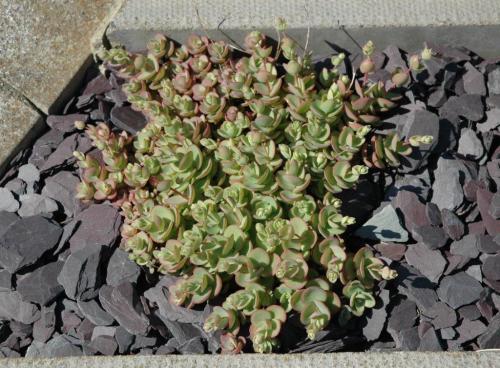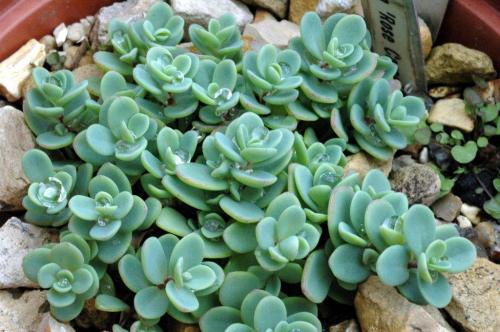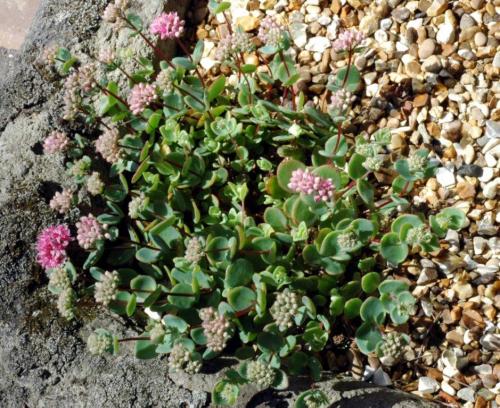EWERSII (Ledebour) H.Ohba, 1977
Synonyms :
Sedum ewersii Ledebour (1829)
Sedum schrotium hort. (s.a.)
Sedum hayesii hort. (s.a.)
Sedum gerardianum Wallich (1828)
Sedum azureum Royle (1835)
Sedum rubrum Royle ex Edgeworth (1846)
Sedum ewersii var. homophyllum Praeger (1921) / Sedum ewersii cv. homophyllum (s.a.)
Sedum altaicum Stephani ex Fröderström (1930)
Sedum ewersii var. cyclophyllum Priszter (1975)
Sedum pakistanicum G.Sarwar (1995)
Section Sieboldia
Distribution : Afghanistan, Pakistan (Karakorum), India (western Himalaya), Tadzhikistan, Kirgizia, Kazakhstan, Russia (Siberia), Mongolia, Tibet, China (Xinjiang, Inner Mongolia).
Description (by H. Ohba in IHSP, 2003) :
Rootstock branching.
Flowering stems caespitose, procumbent to ascending, glabrous, 10 - 20 cm.
Leaves opposite, sessile, orbicular to ovate or obovate, 1.5 - 2 x 1.5 - 2 cm, glaucous to pale green, base cordate, tip rounded to obtuse, margins entire or rarely faintly denticulate.
Inflorescences terminal, dense, 2 - 3 cm wide.
Flowers : Sepals triangular, 1.5 - mm, petals narrowly ovate, 3.5 - 5 mm, pink or pale purple, stamens as long as the petals or shorter, anthers blackish-purple.
Flowering time : July to August.
Cytology : 2n = 20, 22.
Ray Stephenson, Sedum, Cultivated Stonecrops, p. 284f. :
"H. ewersii is a tumbling, crawling, creeping, sprawling species ... with thin but wiry stems, which do not have the strength to support opposite-decussate leaves. Each pair of glaucous-green, sessile leaves is several centimeters from the next pair, so the shiny, brown stems show. Literally hundreds of stems rise, then tumble, on a mature plant, each terminating in a cyme of purple flowers. ....
Main points of distinction : Decumbent stems, 40 cm long and longer with opposite-decussate, amplexicaul leaves are the best indicators. H. sieboldii has a similar habit, but stems are much shorter and its leaves are smaller and ternate. ....
Two very distinct varieties exist in cultivation ....
H. ewersii var. cyclophyllum .... is not a great deal different in form from the type species but much its miniature. Stems 15 cm long are much shorter ... and, as a result, tend to be more erect. Plants are paler througout, leaves are smaller and pale green, and petals are pale pink.............
H. ewersii var. homophyllum ... is a commonly encountered miniature, carpet-forming species, often masquerading as H. pluricaule or H. cyaneum. A network of dried stems is left on the surface in winter, from which short, erect branches arise, carrying light green, opposite-decussate, crowded leaves. Even in full sun, leaves remain light glaucous green ...... a shy flowerer and not as succulent or compact as H. pluricaule which turns purple in sun and is very floriferous.
H. eversii var. homophyllum 'Rose Carpet' (syn. 'Rosenteppich', 'Pink Carpet') ... is recommended because it is much more floriferous than the true variety, it grows a little more lushly, and it is taller (10 cm)."
In cultivation :



Photos Ray Stephenson